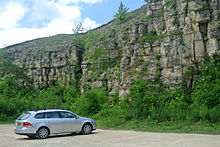Inferior Oolite
| Inferior Oolite Group Stratigraphic range: Aalenian – Bathonian (Middle Jurassic) |
|
|---|---|

Inferior Oolite at Leckhampton Hill, Gloucestershire.
|
|
| Type | Group |
| Underlies | Great Oolite Group |
| Overlies | Lias Group |
| Thickness | 0 - 120m |
| Lithology | |
| Primary | limestones |
| Other | sandstone, mudstone |
| Location | |
| Country | England |
The Inferior Oolite is a sequence of Jurassic age sedimentary rocks in Europe. It was deposited during the Middle Jurassic. The Inferior Oolite Group as more recently defined is a Jurassic lithostratigraphic group (a sequence of rock strata) in southern and eastern England . It has been variously known in the past as the Under Oolite (or Oolyte), the Inferior Oolite, the Inferior Oolite Series and the Redbourne Group.
The rocks are exposed from Dorset and Somerset eastwards and northwards through the English Midlands to Yorkshire. It is present at depth in the Wessex-Weald Basin, where it reaches its greatest thickness of 120m.
The Group comprises up to 120m thickness of oolitic limestones and subordinate sandstones and mudstones laid down during the Jurassic Period. In the East Midlands it comprises (in descending order i.e. oldest last) the Lincolnshire Limestone, Grantham and Northampton Sand formations whereas in the Cotswold Hills it comprises the Salperton Limestone, Aston Limestone and Birdlip Limestone formations. The limestones are rich in organic material. The ammonite Parkinsonia parkinsoni, an index fossil for the Bathonian, is native to the Inferior Oolite of .
Ornithopod tracks geographically located in North Yorkshire, England. Ornithopod and theropod tracks present in North Yorkshire, England.
...
Wikipedia
